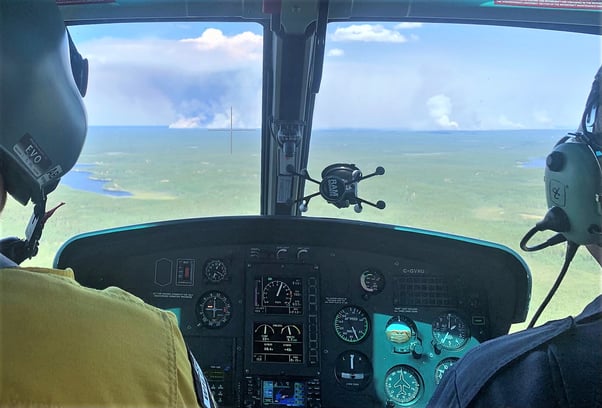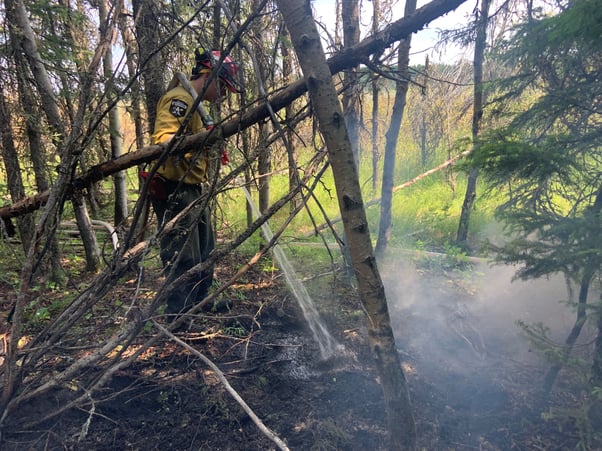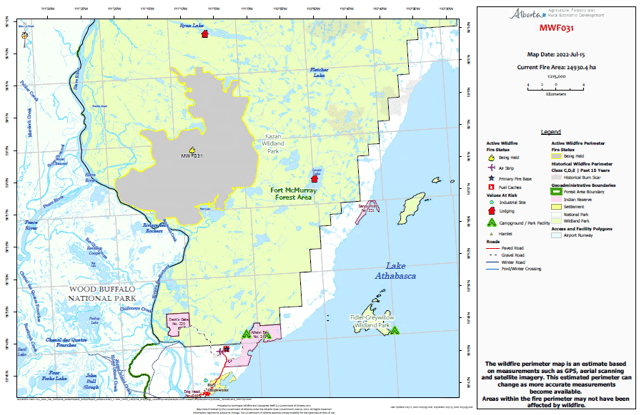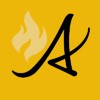
The fire danger in the Fort McMurray Forest Area is overall VERY HIGH, with the exception of the area surrounding Lake Athabasca and to the north where the fire danger is EXTREME.
Please use caution when working or recreating in the outdoors. Always ensure you fully extinguish your campfire and if you see smoke or flame in the forest, call 310-FIRE (3473).

Firefighters are monitoring multiple wildfires in the Fort McMurray Forest Area (July 7, 2022).

A fire ban is in effect within the Fort McMurray Forest Area for the area north of Lake Athabasca. Please visit albertafirebans.ca to see a map of the exact area covered under this fire ban.
Under this ban:
- all existing fire permits are suspended.
Prohibited:
- wood campfires on public land, private land and provincial campgrounds
- backyard fire pits
- charcoal briquette barbecues
- fireworks and exploding targets
Allowed:
- propane or natural gas powered appliances
- indoor wood fires
If you see a wildfire, report it immediately by calling 310-FIRE.
The fire ban will remain in effect until conditions improve.
To view the ministerial order and maps, click here.
WILDFIRE OF NOTE
MWF031 was detected on June 25 and is located 21 km north of Fort Chipewyan. The fire remains on the edge of Flett Lake and is growing towards the north. The wildfire is estimated to be 24,930 hectares (ha) in size and was caused by lightning. It remains classified as being held. This wildfire does not threaten any community at this time. The fire has not grown towards the south and therefore has not gotten closer to Fort Chipewyan or the airport.
Today, minimal fire activity was observed on wildfire MWF031. Firefighters continued to work on strengthening the containment line to the south of the fire. They were assisted by helicopter bucketing operations. The containment line has been established along a natural break located between Flett Lake and the Des Rochers River. It's intended to prevent the wildfire from spreading south.
Another group of firefighters has completed structure protection. They continue to maintain equipment such as pumps, hoses and sprinkler systems on buildings identified as being directly threatened by the wildfire. The structure protection plan for Fort Chipewyan, Allison Bay and Dog Head is complete.
Tomorrow, temperatures are expected to be in the low 20s and humidity will be around 40%. Winds are expected to shift from the southwest to the northwest tomorrow at 15 km/h, with winds gusts up to 35 km/h. Rain and thunderstorms are also expected tomorrow. Smoke could increase in the area, given the weak inversions and change in wind directions. However, it is expected to break by 11 a.m., allowing the smoke to dissipate.
Tomorrow, firefighters and helicopters will continue their indirect attack on the wildfire. A total of 50 firefighters and seven helicopters are assigned to wildfire MWF031 and stationed in Fort Chipewyan. Additional aircraft are available if needed in Fort McMurray.
Local aircraft operators, please be advised that a “notice to airmen” NOTAM is in effect for the area surrounding wildfire MWF031.
FORT MCMURRAY WILDFIRE UPDATE
Since January 1, 2022, there have been 47 wildfires in the Fort McMurray Forest Area, burning a total of 55,694 ha.
MWF015 was detected on June 12 and located 24 km southeast of Fort Fitzgerald, 45 km southeast of Fort Smith and 115 km north of Fort Chipewyan. It is currently estimated to be 3,162 ha in size and classified as being held. This wildfire was caused by lightning.
MWF018 was detected on June 13 and is located 28 km southeast of Fort Fitzgerald, 43 km southeast of Fort Smith and 90 km north of Fort Chipewyan. It is currently estimated to be 2,842 ha in size and classified as being held. This wildfire was caused by lightning.
MWF022 was detected on June 13 and is located 60 km southeast of Fort Fitzgerald and 62 km northeast of Fort Chipewyan. It is currently estimated to be 17,997 ha in size and classified as being held. This wildfire was caused by lightning.
MWF033 was detected on June 30 and is located 30 km southwest of Fort Fitzgerald and 110 km north of Fort Chipewyan. It is currently estimated to be 1,853 ha in size and classified as being held. The fire has reached the west side of Leland Lake. The cause of this wildfire is currently under investigation.
MWF034 was detected on June 30 and is located 50 km southeast of Fort Fitzgerald and 90 km north of Fort Chipewyan. It is currently estimated to be 1,301 ha in size and classified as being held. The cause of this wildfire is currently under investigation.
MWF046 was detected on July 13 and is located approximately 13 km from Bitumount Oil Field Site. It is currently estimated to be 75 ha in size and is classified as out-of-control. This wildfire was caused by lightning. Currently, there are four helicopters, three air tankers, and approximately twenty-five staff working on containing this fire.
*Please be advised that ignition specialists from Alberta Wildfire are planning ignition on the south flank of wildfire MWF046. The burn is planned for July 15 between 4-5pm if conditions permit. Residents/workers will see smoke while the burn is ongoing. The goal of the ignition is to tie the wildfire to natural fuel breaks in an attempt to prevent the wildfire from moving south.*
Since these wildfires are located in remote areas where they do not threaten communities or resources, we allow the wildfires to play out their natural role onto the landscape under the watchful eye of experienced fire managers. Using this wildfire management strategy has many benefits. It re-introduces fire onto the landscape, creates a break in the continuous fuels, reduces the intensity of the fire, provides safety zones for our firefighting crews to work from and reduces the cost of fighting these wildfires.
These wildfires are actively monitored by firefighters on a regular basis and do not threaten any communities at this time.
To learn more about the classification of wildfires, please click here.
To view the wildfires on a map, check out the new wildfire dashboard. It provides up-to-date wildfire information at the click of a button. This interactive tool displays important statistics on the number of active wildfires in the province, sizes, locations, suspected causes and more.
PROVINCIAL WILDFIRE UPDATE
Since January 1, 2022 in the Forest Protection Area, there have been 583 wildfires burning a total of 70,921 ha.


To view the map of MWF031 in full size, click here.
To view a map of all the wildfires in the area north of Lake Athabasca, click here.
SMOKE
Smoke from wildfires in Alberta and elsewhere in North America may drift into the Fort McMurray Forest Area. To view the Air Quality Health Index for your location, visit the interactive map by clicking here. Visit firesmoke.ca to view the smoke forecast and see where the smoke is coming from.
If you have smoke related concerns, we recommend that you visit the Alberta Health FAQs on wildfire smoke by clicking here.
A MESSAGE FROM THE REGIONAL MUNICIPALITY OF WOOD BUFFALO
There are currently no threats to any communities at this time.
Please visit www.rmwb.ca/fortchip for the latest joint update from the Athabasca Chipewyan First Nation, Mikisew Cree First Nation, Fort Chipewyan Métis and the Regional Municipality of Wood Buffalo.
In the event of an evacuation alert or order within the Regional Municipality of Wood Buffalo, we recommend that you download Alertable - Emergency Notifications.
To learn more about how you can protect your property from wildfire, visit the Regional Municipality of Wood Buffalo FireSmart website: www.rmwb.ca/en/fire-and-emergency-services/firesmart
Managing emergencies is all about planning for them in advance. Once a year, a review of the REMP and CEMPs is done to ensure they reflect all the needs of our region. To learn more about the Regional Emergency Management Plan, click here.
FIRESMART
Using FireSmart principles is becoming a way of life for many communities in North America. With so many neighborhoods threatened by wildfire each year, residents are taking action and reducing the risk to their homes, cabins and properties.
Being FireSmart doesn't have to be complicated and there are many resources to help you get started. You can check out some easy tasks by visiting firesmartcanada.ca, click here to watch a video or you can take the FireSmart Canada FREE one-hour course by clicking here.
REQUEST A FIRE PERMIT
Wildfire season in Alberta is from March 1 until October 31. During wildfire season, you are required to have a fire permit if you plan on burning in the Forest Protection Area, with the exception of a campfire.
To request a free fire permit online, visit the new portal. You will need a MyAlberta Digital ID to access the portal. Please note that you can still request your permit from the Fort McMurray forest office by calling 780-743-7125.
For more information regarding fire permits, you can view our video by clicking here.
.png?width=644&name=WF_Social-images%20(7).png)
CONTACT
RELATED INFORMATION
Websites:
- Alberta Wildfire
- Alberta Fire Bans
- FireSmart in Alberta
- Alberta Emergency Alerts
- Air Quality Health Index
- Wildfire Smoke and Your Health
- 511 Road Reports
- Emergency Preparation
Apps:
